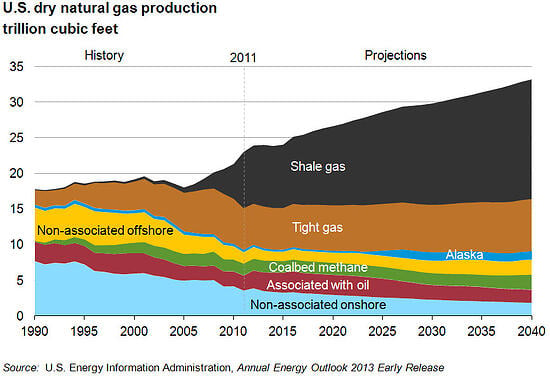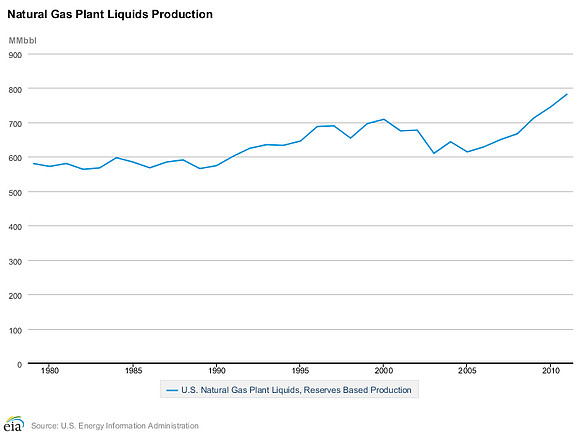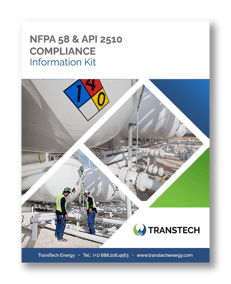Shale Gas Development Surge
Today it is well known that sedimentary rock formations, known as shale, can hold abundant stores of petroleum and natural gas. It is also well understood that the application of hydraulic fracturing— ‘fracking’—along with advanced horizontal drilling methods, have allowed for new access to stores of shale gas that were previously uneconomical to obtain.
As reported by the U.S. Department of Energy, although natural gas production from shale formations has taken place for decades, it is only due to these recent advances in technologies and methods of extraction that in more recent years have allowed for the current boom in the U.S. natural gas industry.
Projections published by the U.S. Energy Information Administration predict U.S. natural gas production will increase from the 23 trillion cubic feet reported in 2011 to 33.1 trillion cubic feet in 2040, an increase of 44% —with the majority of growth attributed to projected increases in shale gas production, estimated to climb a whopping 114% from 7.8 trillion cubic feet in 2011 to 16.7 trillion feet in 2040.

Natural Gas and NGLs go Hand-in-Hand
Garnering growing attention is the corresponding growth in the supply of natural gas liquids (NGLs), which have long been considered by-products of natural gas drilling, but are becoming increasingly attractive in their own right as a target of exploration, due in part to skyrocketing crude oil prices which have a corresponding positive impact on the value of NGLs.
The output of shale gas field production varies widely by basin and region, but typical extraction efforts yield a raw mix of hydrocarbon gas, predominantly comprised of methane (CH4), but often also produce a number of other relatively light hydrocarbons including ethane (C2H6), propane (C3H8), butane (n-C4H10), isobutene (C4H10), and pentane (C5H12 or natural gasoline), which are collectively grouped as natural gas liquids (NGLs).
NGLs may be gaseous or liquid underground, depending on pressure and temperature, however they are easily condensable and separated at the surface. Natural gas is commonly referred to as being either ‘dry’ or ‘wet’, with dry gas being made up almost exclusively of methane alone, while wet gas indicates notable presence of NGLs.
The shale gas boom along with the growing interest in wet gas, has led to a corresponding boost in NGL production.

Extracting High Value NGLs
While operations vary, gas extracted from the field often goes through initial processing close to the drilling site to remove water, nitrogen, carbon dioxide and other impurities. It is then typically transported through small diameter gathering lines to a natural gas processing plant. Here, pipeline quality methane -- the gas commonly used for power generation -- will be separated from NGLs and directed to mainline natural gas pipelines for delivery to residential, commercial and industrial users.
What remains, often referred to as ‘Y-grade’, is the NGL mix, ready for delivery to a fractionation plant where the remaining individual NGL components—ethane, propane, butanes and pentane—can be separated. Y-grade is often delivered by pipeline, but may also may be delivered by rail or truck.
Regardless of transportation method, in typical operations, incoming mixed NGLs require initial warehousing to buffer delivery level variation and maintain a steady flow-rate into processing. NGL may be stored in ‘natural’ underground facilities such as salt caverns, aquifers and depleted reservoirs as well as in both underground and above-ground storage tanks. Often a combination of storage methods is employed.
NGL & LPG: The Road to Market
Following the fractionation process, the final journey for NGLs takes individual end products from the fractionation plant to their corresponding markets. In many cases, fractionation plants are located in close vicinity to chemical plants and refineries where some NGLs (ethane, pentanes) will conclude their journey.
Where possible, NGL pipelines will be used to transport products directly from fractionators to end customers or related storage facilities, but in cases where pipeline capacity is limited or unavailable, truck and rail delivery options are utilized.
While Ethane is more volatile and primarily delivered via pipeline to predominantly petrochemical customers, LPG (butane and propane, and often the two combined) is easily stored in pressure vessels and transported via rail, truck or coastal tanker to market centers or directly to industrial, agricultural and retail customers.
NGL and LPG storage terminals are critical components in supporting the delivery chain, providing unloading facilities to receive products from one source (rail, truck, pipeline or marine) and reloading capabilities for transferring respective products to the next carrier.
Also offering temporary storage to help maintain throughput and accommodate supply and demand cycles, NGL and LPG storage terminals can be found throughout the NGL delivery chain. Single product or multi-product terminals may be employed, depending on location and vicinity to related end markets.
NGL & LPG Terminals Demand Spike
With the significant increase in shale gas development and corresponding NGL production growth, it comes as no surprise there is new pressure on every point in the NGL delivery chain. The related need for LPG and NGL terminal facilities is no exception.
“We are experiencing a significant increase in our NGL and LPG storage and terminal engineering and construction business” said Greg Ezzell, Director of Business Development, TransTech Energy, “With pipeline capacity growing at a relatively slow pace with respect to NGL production increases, demand for truck and rail delivery is climbing at a pace beyond overall growth to absorb not only the notable increase in NGL and LPG production, but also to supplement pipeline capacity.”
Given the projected growth of shale gas development and related NGL and LPG output into the year 2040, midstream infrastructure demands are not expected to slow down any time soon.
Click here to learn more about TransTech Energy’s LPG & NGL storage terminal engineering and construction services or contact us at (252) 446-4357 to discuss your current project needs.
Free Sample Project Review – Let us share similar scope terminal construction project specs with you – includes sample P&ID, budgetary pricing review, more.






